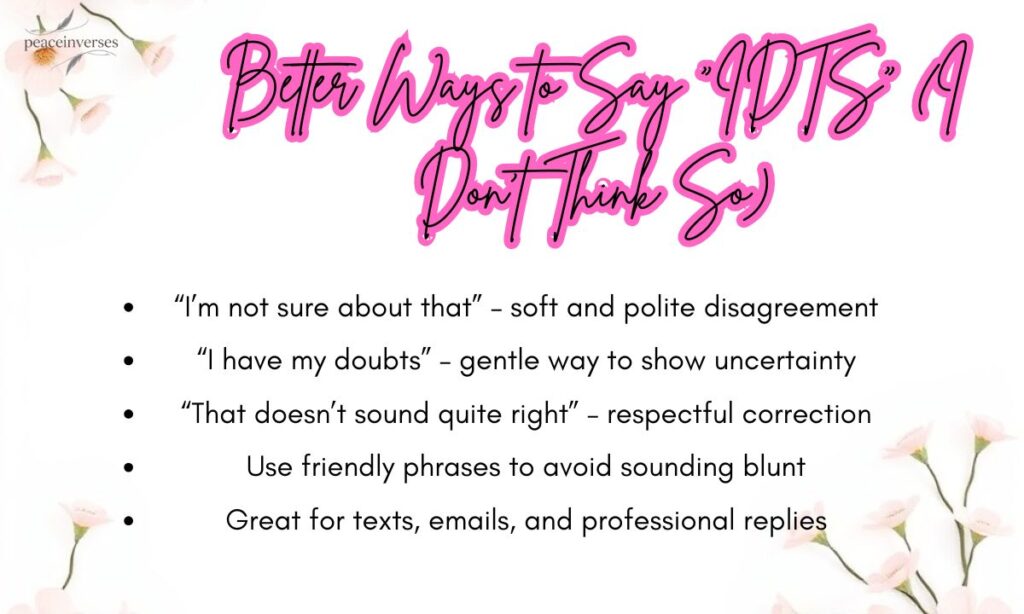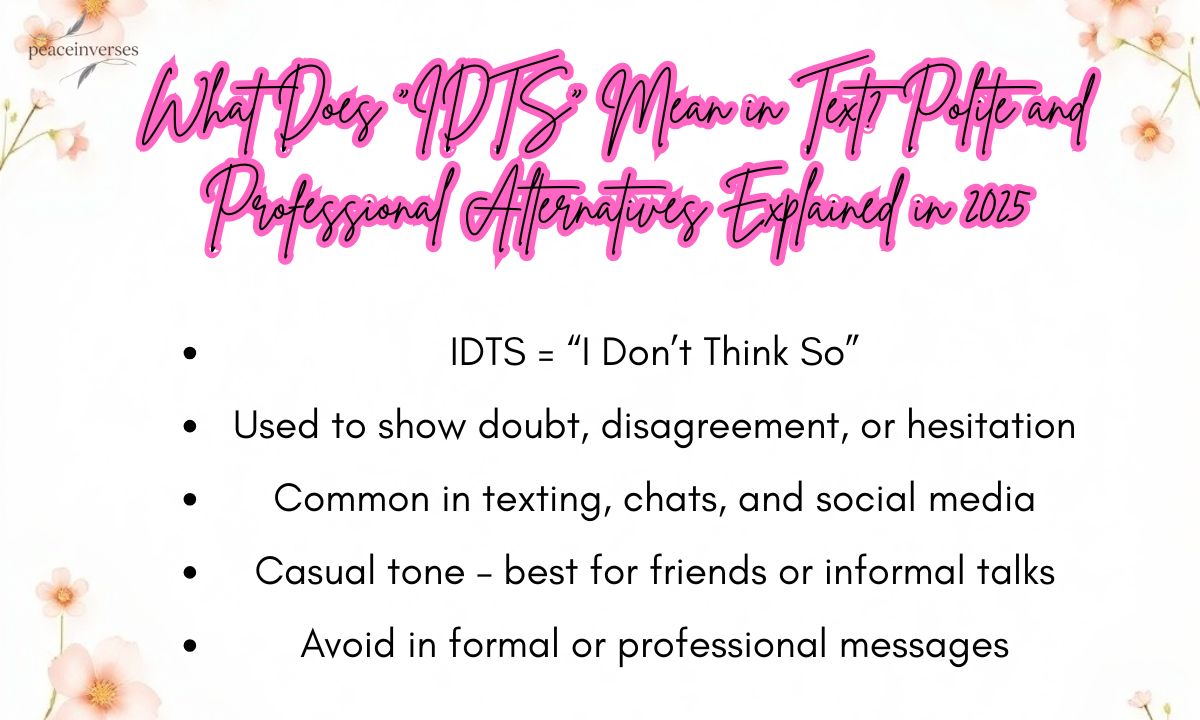Ever seen “IDTS” in a text and paused for a second? You’re not alone. This four-letter abbreviation is everywhere in chats, social media comments, and group messages. It stands for “I Don’t Think So,” a quick way to express doubt or a polite “no” without typing the whole phrase.
But in 2025, tone matters more than ever. A casual “IDTS” can feel blunt or dismissive in the wrong context. That’s why it helps to know not just what it means, but also how to use it—and when to pick a more thoughtful alternative.
Introduction to IDTS in Digital Communication
IDTS is a popular texting abbreviation that stands for “I Don’t Think So.” It’s commonly used in everyday chats, group messages, and social media replies. The phrase saves time and keeps conversations short and informal.
In the world of fast digital communication, short responses like IDTS help people reply quickly without breaking the flow of a conversation. It’s especially common among younger users who are used to abbreviations.
However, IDTS is not always suitable for every situation. While it works in casual conversations, it can feel out of place in professional or formal settings where tone and clarity matter.
Common Uses of “IDTS” in Texting
People use IDTS when they want to sound casual but clear. It often replaces longer phrases like “I don’t think that’s true” or “I doubt it.” This makes it ideal for quick, informal responses.
It’s also used to lightly disagree without sounding harsh. Many use it in friendly chats where they want to keep the mood relaxed and avoid long explanations.
For example, someone might text “IDTS 😅” to politely dismiss an idea in a group chat without hurting feelings.
Expressing Doubt or Hesitation
Sometimes you’re not sure about a fact, plan, or opinion. IDTS helps express that doubt in a quick, non-serious way.
It’s often used when you’re unsure but don’t want to say a definite “no.” This makes it useful in casual decision-making conversations with friends or peers.
Examples of expressing doubt with IDTS:
- “Do you think the store is open this late?” → “IDTS, it’s past 11 PM.”
- “Will they win the match tonight?” → “IDTS, the other team looks stronger.”
- “Is this news real?” → “IDTS, let’s check the source first.”
Softening a Polite “No”
IDTS is often used to decline politely without being blunt. It replaces a firm “no” with something lighter and more conversational.
This tone helps keep friendly chats comfortable and positive, even when you’re disagreeing or rejecting a suggestion.
Examples of soft refusals using IDTS:
- “Want to go hiking tomorrow?” → “IDTS, I might be busy.”
- “Are you coming to the party?” → “IDTS, I’m staying in tonight.”
- “Should we buy that game?” → “IDTS, it’s too expensive right now.”
Is “IDTS” Rude or Too Casual?
In most casual conversations, IDTS isn’t rude. Friends often use it playfully or with emojis to keep the tone light.
However, in professional or serious discussions, it can feel too short or dismissive. Without context, some people might think you’re being abrupt.
To avoid misunderstandings, it’s important to consider your audience and the setting. If the tone is formal, use a full sentence instead of IDTS.
When and How to Use “IDTS” Properly
The best time to use IDTS is in relaxed, informal chats where everyone is comfortable with abbreviations.
Avoid using it in work emails, academic messages, or with strangers, as it can come across as unprofessional or overly casual.
Quick guidelines for proper use:
- Use in casual texting: Friends, family, social media.
- Avoid in formal settings: Work, interviews, academic contexts.
- Add context or emojis to make it feel friendly: “IDTS 😅” or “IDTS, maybe later.”
Alternative Meanings of “IDTS” You Should Know
While “I Don’t Think So” is the main meaning, IDTS can mean different things in niche communities.
For example, in gaming groups, some use it as “I Don’t Take Suggestions” to set boundaries in team play.
Other rare meanings include “I Don’t Tell Stories,” though these are less common and usually clear from the conversation’s context.
IDTS vs. Similar Text Abbreviations (IDK, IMO, etc.)
Many texting abbreviations look alike, but each has a different purpose. For example, IDTS means “I Don’t Think So,” while IDK means “I Don’t Know.” These small differences change how your message feels.
IDTS shows doubt or disagreement, while IMO (In My Opinion) simply shares a viewpoint. Mixing them up can confuse the tone of your response.
Learning the distinctions helps you communicate more clearly and choose the right abbreviation for every situation.
Key Comparisons:
- IDTS – Shows doubt or polite disagreement
- IDK – Admits not knowing something
- IMO / IMHO – Shares a personal opinion, often neutral
- IDC – Says “I Don’t Care,” which can sound blunt or rude
- TBH – Means “To Be Honest,” often used for honesty or emphasis
Examples of “IDTS” in Real Conversations
Seeing IDTS in context makes it easier to understand how people use it naturally. These examples show how tone and emojis can change the meaning.
In most chats, IDTS appears as a quick reply that saves time while still being polite. It’s often followed by an explanation or emoji to keep it friendly.
Here are some realistic examples:
- “Do you think we’ll get a discount?” → “IDTS, maybe next time.”
- “Is this rumor true?” → “IDTS 🤔 let’s wait for the news.”
- “Will it rain later?” → “IDTS, the forecast says sunny.”
- “Are we winning the match?” → “IDTS 😅 it’s not looking good.”
Why “IDTS” Is Popular in Online Chats and Social Media
People love shortcuts that save time, and IDTS is quick to type. It lets you share your opinion or doubt without writing full sentences.
On platforms like Twitter, TikTok, and Instagram, short responses feel more natural and match the fast pace of conversations.
Another reason for its popularity is that it feels lighthearted and casual, which fits well with memes, comments, and playful debates online.
Understanding the Informal Tone of “IDTS”
IDTS is inherently informal. It works best among friends, peers, or in online spaces where relaxed language is expected.
The abbreviation can feel too casual or abrupt in work-related texts or with people you don’t know well. Tone is often misunderstood without context.
To make it friendlier, many add emojis or extra words: “IDTS 😂” or “IDTS, but that’s just me.” This softens the message and avoids sounding rude.
Cultural Differences in the Use of “IDTS”
Not every culture uses abbreviations the same way. In some countries, people prefer full sentences and might see abbreviations as lazy or impolite.
In regions where English texting slang is common, IDTS is widely understood and seen as casual, not rude.
When chatting with someone from another culture, it’s safer to avoid slang until you’re sure they understand or use the same style of texting.
Texting Etiquette: When to Avoid Using “IDTS”
While IDTS is fine in friendly chats, it’s not always appropriate. Knowing when to avoid it helps you maintain good communication etiquette.
In professional or academic settings, abbreviations like IDTS can seem careless or unprofessional. A full response shows more respect.
Avoid using IDTS in these situations:
- Work emails or messages to managers
- Formal invitations or RSVPs
- Serious discussions where tone matters
- Texts to new acquaintances or clients
15 Better Ways to Say “IDTS” (I Don’t Think So)

1. I’m not sure about that.
This phrase shows uncertainty without sounding rude. It’s useful when you don’t fully agree but want to stay polite and open-minded. You can use it in both casual and semi-formal chats, making it a flexible alternative to IDTS.
Examples:
- “Do you think the meeting is still on?” → “I’m not sure about that, we should confirm.”
- “Is the shop open late tonight?” → “I’m not sure about that, maybe check online.”
- “Are they really moving to another city?” → “I’m not sure about that, let’s wait and see.”
2. That doesn’t sound quite right.
This phrase gently questions accuracy without shutting the other person down. It’s a polite way to express doubt. It’s great for friendly debates or fact-checking when you want to avoid sounding dismissive.
Examples:
- “They said the event starts at 10 PM.” → “That doesn’t sound quite right, I thought it was 8 PM.”
- “I heard tickets are free for everyone.” → “That doesn’t sound quite right, I saw a price listed online.”
- “We don’t need ID for the flight.” → “That doesn’t sound quite right, let’s check the rules.”
3. I’m not convinced.
This phrase shows healthy skepticism and is common in discussions or when hearing surprising claims. It sounds slightly stronger than IDTS but still polite if used in the right tone.
Examples:
- “This new app will change everything!” → “I’m not convinced, it needs better reviews first.”
- “We can finish the project by tomorrow.” → “I’m not convinced, that’s too soon.”
- “He’s telling the truth about that story.” → “I’m not convinced, his details keep changing.”
4. I have my doubts.
This phrase softens disagreement and works well in both casual chats and mild debates. It’s often used when you feel uncertain but don’t want to argue directly.
Examples:
- “She’ll remember to bring the forms.” → “I have my doubts, she usually forgets.”
- “This shortcut saves a lot of time.” → “I have my doubts, it looks longer on the map.”
- “They’ll arrive on time.” → “I have my doubts, traffic is really bad today.”
5. I don’t believe that’s the case.
This is a polite but formal way to express disagreement. It’s great for emails or respectful discussions. It shows that you’ve thought about the topic and simply don’t agree with the statement.
Examples:
- “Everyone has already agreed to this plan.” → “I don’t believe that’s the case, some haven’t responded yet.”
- “The product is out of stock everywhere.” → “I don’t believe that’s the case, I saw it online earlier.”
- “The meeting was canceled.” → “I don’t believe that’s the case, it’s just been delayed.”
6. I’m not entirely sure.
This phrase shows uncertainty without full disagreement. It’s perfect when you need to be cautious about your response. You can use it in friendly chats or when you want to sound less absolute.
Examples:
- “Is the delivery coming today?” → “I’m not entirely sure, we should check the tracking.”
- “Are they staying for dinner?” → “I’m not entirely sure, they didn’t say yet.”
- “This is the correct address, right?” → “I’m not entirely sure, let’s double-check.”
7. I could be wrong, but…
This phrase adds humility to your opinion. It shows you’re open to correction, which softens the tone. It works especially well in group chats or discussions where you want to keep things friendly.
Examples:
- “The answer is definitely 42.” → “I could be wrong, but I think it’s 43.”
- “She’s the new manager.” → “I could be wrong, but I thought she was still in training.”
- “The store opens at 9 AM.” → “I could be wrong, but I think it’s 10 AM.”
8. I’d have to disagree with that.
This is a direct but respectful way to say you don’t agree with someone’s point of view. It’s useful in debates or discussions where you need to be clear but not rude.
Examples:
- “Pizza is better without cheese.” → “I’d have to disagree with that, cheese makes it perfect.”
- “We should skip the safety test.” → “I’d have to disagree with that, it’s too risky.”
- “Winter is the best season.” → “I’d have to disagree with that, I prefer summer.”
9. That’s not how I see it.
This phrase lets you share your perspective without sounding confrontational. It’s a polite way to acknowledge a difference in opinion.
Examples:
- “This plan will save us time.” → “That’s not how I see it, it might add extra work.”
- “The movie was boring.” → “That’s not how I see it, I found it interesting.”
- “He handled the problem well.” → “That’s not how I see it, he could’ve done better.”
10. It seems unlikely.
This phrase expresses skepticism about the possibility of something happening. It’s perfect when you’re discussing predictions or future events.
Examples:
- “We’ll win the jackpot tonight.” → “It seems unlikely, but good luck!”
- “The train will arrive early.” → “It seems unlikely, it’s always late.”
- “They’ll agree to this deal immediately.” → “It seems unlikely, they usually take time.”
11. I’m doubtful.
This is a short and simple way to show you don’t have confidence in something. It’s slightly stronger than “I’m not sure” but still polite in tone.
Examples:
- “He’ll call back in five minutes.” → “I’m doubtful, he’s usually late.”
- “The exam will be easy.” → “I’m doubtful, it covers a lot of topics.”
- “They’ll finish the project today.” → “I’m doubtful, it looks incomplete.”
12. That may not be correct.
This phrase sounds polite and constructive, great for professional or academic settings. It points out a possible mistake without being harsh or offensive.
Examples:
- “The capital of Australia is Sydney.” → “That may not be correct, it’s actually Canberra.”
- “We only have one payment option.” → “That may not be correct, I saw another listed online.”
- “This is the fastest route.” → “That may not be correct, maps show a shorter one.”
13. I’m leaning toward a different conclusion.
This phrase is thoughtful and formal, showing that you’ve considered the facts but see things differently. It’s great for meetings or thoughtful discussions where you want to sound respectful.
Examples:
- “The data supports this theory.” → “I’m leaning toward a different conclusion based on the results.”
- “We should cancel the trip.” → “I’m leaning toward a different conclusion, maybe we can reschedule instead.”
- “She’s the best candidate.” → “I’m leaning toward a different conclusion after reviewing the resumes.”
14. I’m not on the same page.
This phrase shows you don’t fully agree or understand what someone else is thinking. It’s especially useful in teamwork or planning conversations.
Examples:
- “We’re all okay with this deadline.” → “I’m not on the same page, I think we need more time.”
- “We’ll skip the meeting.” → “I’m not on the same page, I believe it’s important to attend.”
- “Everyone agrees on this design.” → “I’m not on the same page, I prefer a different style.”
15. I don’t think that’s accurate.
This phrase sounds firm yet polite, especially when correcting misinformation. It’s great for professional corrections or factual discussions.
Examples:
- “This graph shows last year’s sales.” → “I don’t think that’s accurate, it’s from two years ago.”
- “The price hasn’t changed.” → “I don’t think that’s accurate, it increased last month.”
- “This fact is in the report.” → “I don’t think that’s accurate, I checked and it wasn’t included.”
Tone Matters: Choosing the Right Alternative
The tone you choose can change how your message feels. A friendly phrase can soften disagreement, while a sharp one might sound dismissive.
Consider the context, relationship, and emotions of the conversation before deciding which alternative to use.
A good choice shows respect, empathy, and clarity, helping you avoid misunderstandings.
Frequently Asked Questions
Is “IDTS” rude to use?
Not always. It depends on tone and context. In casual chats, it’s fine, but it can feel blunt in formal or sensitive conversations.
Where is “IDTS” most commonly used?
You’ll mostly see it in text messages, social media comments, and group chats. It’s rarely used in formal emails or work reports.
Can I use “IDTS” in professional emails?
It’s better not to. Choose polite alternatives like “I’m not sure about that” to sound more professional and respectful.
Does “IDTS” always mean “I Don’t Think So”?
Mostly, yes. But sometimes it’s used jokingly or sarcastically. The meaning depends on tone and context.
What’s the best polite alternative to “IDTS”?
“I’m not sure about that” or “I could be wrong, but…” are great polite options. They’re friendly and less abrupt.
Final Thoughts
Learning to replace “IDTS” with thoughtful phrases makes your conversations smoother and more respectful.
The right words can defuse tension, build understanding, and show professionalism—even in short texts.
Next time you want to say “IDTS,” pause for a second. Choose a phrase that fits the tone and strengthens your communication.

Muhammad Shoaib is a passionate faith-based writer with over 10 years of experience in creating meaningful content centered around prayers, Bible meanings, scriptural teachings, and heartfelt wishes. He is the lead writer at PeaceInVerses.com, where he shares spiritual insights and uplifting messages to guide and inspire readers on their faith journey.

